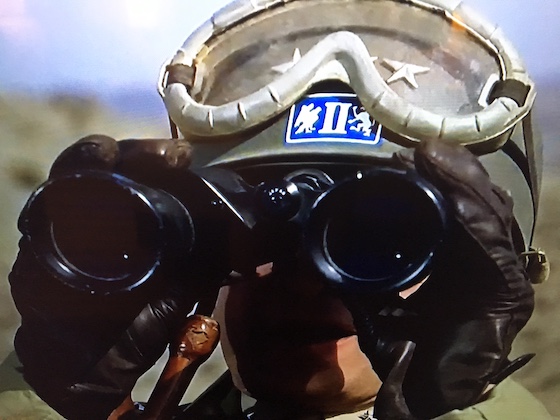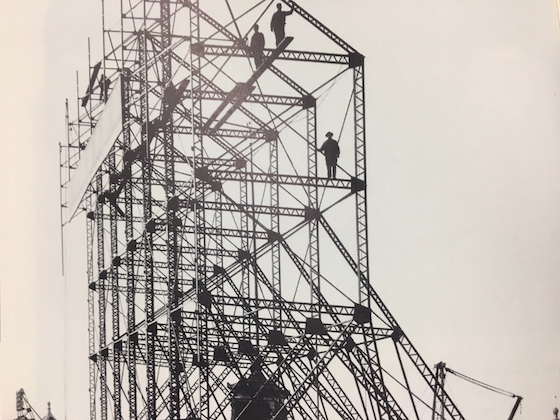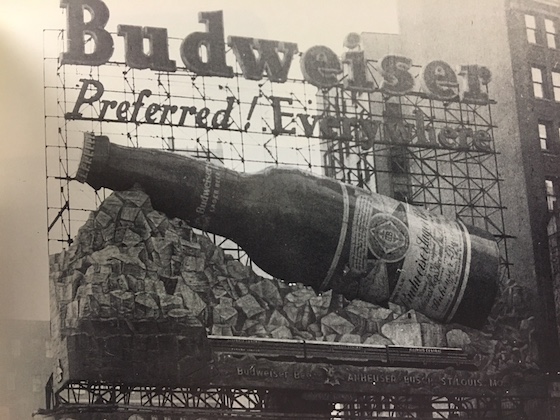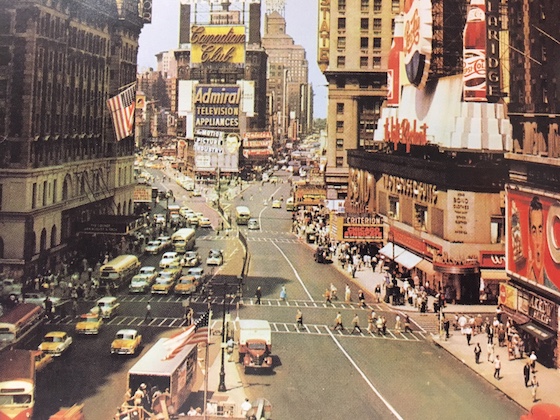Memo From Frank
With all the discussion of repealing various laws in the U.S., such as the SAFE Act and Dodd-Frank, it’s an important time to reflect on the one law that maintains high values or billboards: the Highway Beautification Act. This law, passed in the 1960s, made the entire billboard industry federally controlled. While the government has controlled industries before --- such as trucking and air travel – most industries that the government regulates are later de-regulated to foster greater competition and lower prices. But that’s not the case for the billboard industry. The problem is that no city or state wants there to be a proliferation of signs, so they really can never end the regulation. So billboards have a unique position in which they will always be protected by the Federal Government, and are not subject to repeal. That’s what has given them a unique advantage over other media sectors, and always will.
Why Billboard Success Is All About Strategy

In World War II, the successful generals were masters of strategy. And the same is true for successful billboard investors. The ability to map out a game plan for where to place signs and find advertisers is an essential part of engaging in the battle for big profits in outdoor advertising.
Understanding the laws
Any discussion of strategy regarding billboards must always begin with understanding state and local laws. Billboards have a unique position under the auspices of the Highway Beautification Act. This law, passed in 1968, controls all billboards built within roughly 660 feet of the right-of-way, and restricts billboards to certain spacings and zonings. You cannot be a successful billboard strategist unless you know these rules and regulations backwards and forwards.
Establishing your territory
The normal territory for a billboard company begins with about a four-hour radius drive from your home. Take a compass and draw a circle four-hours distant from where you live. Four hours is a good distance as you can get out to any spot in this territory – and back – in one day. It also creates a fairly large foot print in most areas, typically including more than one state.
Prioritizing your territory
Once you’ve built that circle, divide in into four quadrants. Now it’s time to decide which of these four sectors has the most potential. One interesting item to map out is where the Walmarts are. Walmart has an unbelievable knack in selecting sites that have super high growth potential. If you see one quadrant that has a superior concentration of WalMart stores, then that’s your winner. Another item to map out, which will give equal clues as to future development, is the proposed new highway construction schedule. This is produced by the Highway Department in each state, and tells you future road projects, which is another affirmation of what areas are developing faster. Normally, the new roads and the Walmarts will be in that same quadrant.
Understanding the methodology
Next you need to have a handle on how billboard locations are identified. First, you need to get the city and state ordinances and understand their requirements. Next you have to obtain the local zoning maps and color code the legal zonings. Then you have to measure the spacing between these legal zonings and existing billboards. Once you understand how the process works, it becomes like a video game – you keep getting faster and more proficient at it.
Working smart
When you are trying to build a solid portfolio of billboards fast, the key is to work smart. You should always be looking for shortcuts and how to save steps for maximum efficiency. You will also begin to notice certain signs of a market with strong potential, such as newly zoned commercial land and markets that have few competitors. When you work smart, you can double or triple your productivity.
Constantly learning
A smart strategist always learns from their life experiences. They measure the cause and effect of every action and become focused on what yields the results they want. If you find that a certain type of talking to the property owner yields a higher closing ratio, then you should adopt that pitch at every meeting. You can never stop learning how to do things better, and always keep an open mind.
Watching for the big opportunities
When you are working your territory, you will sometimes encounter your “big break”. Don’t be afraid to take advantage of that opportunity, as these can be gamechangers. I was able to build every steel monopole billboard on I-20 between Forney and Terrell, Texas because I knew that there was about to be a huge demand change as a result of the casinos in Shreveport, and I happened upon a bunch of unbuilt billboard locations. When you find big breaks, don’t question your luck and don’t forget that “time kills deals”.
Conclusion
Strategy is a huge component of building a successful billboard portfolio and building it fast. Think like a World War II commander, map out your plan, and then attack it relentlessly.
Billboard Home Study Course
![]() How to Find a Billboard Location
How to Find a Billboard Location
![]() How to Buy a Billboard
How to Buy a Billboard
![]() How to Build a Billboard
How to Build a Billboard
![]() How to Operate a Billboard
How to Operate a Billboard
![]() How to Rent Ad Space on a Billboard
How to Rent Ad Space on a Billboard
![]() How to Sell a Billboard
How to Sell a Billboard
Get Your Copy Now!
One Of The Most Famous Billboards In U.S. History

This sign was a fixture of Times Square from 1941 to 1966. The billboard blew “smoke rings” made of steam for 25 straight years. These type of billboards were landmarks and a part of American history. Unfortunately, there are very few signs of this importance to be found today – but maybe you can build the next one.
How To Annually Inspect A Billboard Structure

Although billboards are very low maintenance, you cannot simply build them and abandon them. Even though the time clock may be the only moving part, there are issues that can arise from wind load and being outdoors that do require periodic inspection. So how do you accomplish this?
Build a schedule of regular inspection
Just like you have a regular doctor and dentist check-up annually, you should put a date in your calendar each year to determine your billboard structure’s health. The correct interval is annually, but you can probably roll that to less frequently if the sign is wooden or does not overhang anything that would be damaged if it fell.
Wooden structures
You’ll need to go out to the sign structure and examine two items: 1) the poles and 2) the panels. Wooden billboards are very simple in design, and where things go bad is if the poles snap or the panels fall off. There is typically quite a bit of advanced warning if you only go out and take a look at the sign structure. If the poles are rotting, they will start cracking near ground level, and if the foundations are weakening, the poles will begin to lean. You will see rotted panels from the wood becoming discolored and/or warping and the panels pulling away from the nails in the stringers that hold them up.
Steel structures
These will require a professional to climb the sign and take a look (although if you have a limited budget, you can do some of these things from the ground with binoculars). You should start at the ground level to see if there is any evidence of the sign leaning (this is rare with monopoles). Also, look for any indication of any cracking or welds breaking from the ground level to about 5’ above ground (this is the highest pressure point on the sign when the wind blows). Next, look at the two plates on the top of the pole where the head of the sign bolts to the pole (also called the saddle). Look to make sure that none of the 16 or so bolts have fallen off, or that the bolts have “backed off” due to vibration. Additionally, look over the entire superstructure for any broken welds or loose items. Obviously, this is much easier in the air, but you can still spot serious problems often with binoculars from the ground – and that’s definitely better than nothing.
Timers and breakers
While you are there, also take a look at the timeclock and breaker box. Look for evidence of scorching or ant/insect infestation that can cause malfunction. Unfortunately, the warmth and vibration of electrical current attracts insects to nest in these boxes, and they can actually pack in so tight that the timer can’t function.
Act on problems quickly
If you find any problems, you need to get them fixed immediately. You might be only one major storm away from significant loss. If you do an annual inspection, you should be able to avoid most any problem. With 300 billboards being annually inspected for almost two decades, I only had one sign collapse and that was in a tornado.
Conclusion
All billboards, just like humans, need to have a regular check-up. It’s the only way to ensure that there are no festering problems that can lead to much more costly endings.
This Sign Had It All

What doesn’t this sign have going for it? Not only a giant beer bottle and neon lettering – this sign included a model train that ran around the base of the sign 24 hours a day! The train was re-painted monthly to resemble a different rail line, and was a fixture of New York City for roughly ten years from 1947 to 1957. You can imagine just how remarkable this sign was to pedestrians and drivers during this period.
A Primer On Unusual Billboard Configurations

The basic steel monopole billboard is what’s called a “back-to-back center-mount”. What does that mean? It means that the pole is in the middle of the sign face and the two sign faces run parallel to each other. However, in certain applications, this type of structure will not suffice. So what are the unusual billboard configurations available in extreme situations?
The Flag
What do you do when the place the pole needs to be located at does not work based on what’s underneath the sign, such as where the driveway is or the dumpster? Then you build a flag structure, which is one in which the sign is located at the end of the sign face. In developed properties, flags are extremely common due to obstructions to building a center-mount.
The Offset
What about cases where the sign pole needs to be located right up against the property line. This requires an offset configuration. The pole goes up, then a second pole goes sideways and the sign attaches atop that horizontal offset.
The Full-Flag Offset
Sometimes you have to combine the two, when the pole location cannot be in either the middle of the sign face or sufficiently far from the property line not to overhang it. These signs have huge forces on them when the wind blows – or just in supporting its own weight. As a result, they are very expensive to build.
The Super-Flag
One remarkable structure – found most frequently in California – is the super-flag. These structures allow the sign pole to be located behind the shopping center or gas station that fronts the street, and then the sign hangs out over the building and closer to the street. These are extremely expensive to construct, and that’s why you find them only in markets where the ad rents are high enough to warrant that.
The “V”
These are pretty common – billboards in which the two faces of the sign spread apart at the back, so that the sign faces are angled to the street. While it may not sound like much, the difference in engineering between a back-to-back and a “V” is huge, and the cost follows suit. But the common thought is that the additional cost is well worth it, as signs with a “V” rent for more money.
The Super “V”
In cases of significantly blocked visibility, some billboards use a much greater angle to the ad faces, which is called a “super V”. These can be very costly as the cost of the steel and weight goes up exponentially as you make the “V” gigantic.
The Tri-Face
This takes the “V” to its highest level, as the width between the two rear faces of the sign becomes so huge that you can add another entire face to the sign facing the traffic behind the sign. Of course, its application only works if there is a road that can see the sign from the rear. This is the most expensive sign structure, as you are building not a two-face sign but a three-face sign.
Conclusion
Prior to the invention of the steel monopole sign, billboard locations were limited to situations in which the sign could fit on the property in a very basic manner. With these extreme structure options, you can fit a billboard on virtually any property in the U.S.
Why Traffic Jams Are Great For Billboards

Many people get on the highway and hit a snag like this and complain. But billboard owners smile. High levels of traffic, and slower to stopped traffic, increase billboard rents and values. The customer who is stuck in traffic has more time to read signs – and more boredom to make you read them. It’s interesting to note that the cities with the highest ad rents in the U.S., also have the worst traffic problems, such as Los Angeles, New York City and Chicago. Huge traffic equals huge billboard rents. So if you’re in the billboard business, you’ll look at heavy traffic in a new light – and a uniquely positive one.
Advanced Methods Of Beautifying Sign Structures

Although sign owners think mostly about how a billboard looks to the traffic passing by on the highway – the ones that the advertisers are trying to reach – it is not smart to ignore the impact to the property below. The land owner who is unhappy will potentially not renew your ground lease – or let you build the sign to begin with. So how can you make a billboard more attractive from the land owner’s perspective?
Covering the column
One interesting way to improve the appearance of a billboard from the ground is to cover the pole with a substance other that is more adaptive to the neighborhood, such as brick or stucco. This type of improvement can be very expensive, however, as signs were never intended for this addition, and it often requires completely re-engineering the access ladders, etc.
The head of the sign in profile
Putting vertical panels on the end of each sign face – which gives the head of the sign a solid appearance – is also an option. Nobody would disagree that the angle iron that is visible at the end of the sign is unappealing. Boxing in the ends can frequently make the sign significantly more palatable.
Custom paint colors
This is an inexpensive option that is not a budget-buster. You simply paint the sign structure to match the color scheme of the property below. You would think that every sign owner would do this, but many are so intent on standardization that they think all sign poles must be one color. The truth is that there is absolutely no reason you cannot paint the sign to match each property.
Landscaping
Although it’s not immediate gratification, there’s no reason that you can’t landscape around the base of the sign to help it blend into the property at large. The small bush of today is the mighty shrub of tomorrow. It may take years for the plantings to visually hide the base of the sign, but it may well be worth it long term.
Conclusion
Billboard structures are not the prettiest thing in the world. Their only goal is to hold the advertisement up. Taking proactive steps to hide them may just be the best thing you can do to get the property owner to say “yes” on building or renewing your lease.
A Glimpse Of The Glamor Of 1950s Billboards

The 1950s were a great time in American history on many fronts. Landmark automotive design, the invention of popular attractions such as drive-ins and professional sports, and the growth of American industry to the clear leader of the world. It was also a great time for American billboards. They were big, bright, bold and beautiful. Some would say that the 1950’s were the pinnacle of outdoor advertising, but it’s unfair to claim that it was greater enthusiasm, as these signs were built before the advent of the Highway Beautification Act in the 1960s, which limited their size, lighting and motion.
The Market Report
Prices Are Delayed By At Least 15 Minutes
